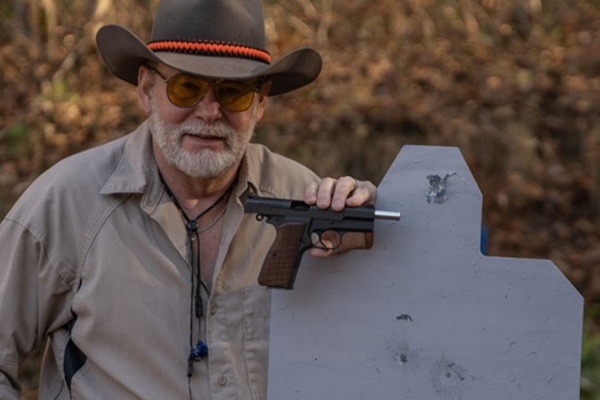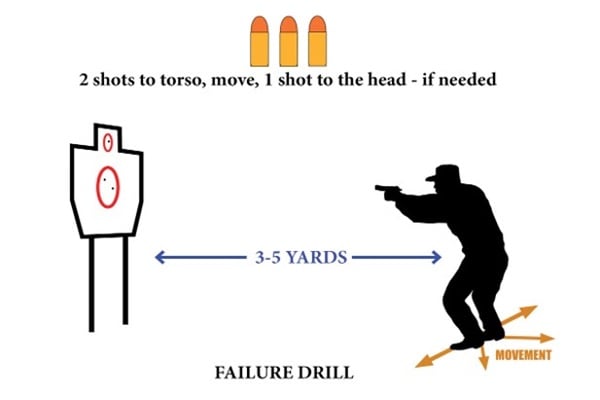Here are two ways to shoot one of the most famous defensive handgun drills ever created
The Failure Drill was conceived by Gunsite Academy founder, former Marine, and gun writer, Jeff Cooper.
During the Mozambique war of independence, an acquaintance of Cooper’s was assaulted by a combatant armed with an AK47.
Cooper’s friend shot his assailant twice in the chest with a Browning HiPower. The two shots did not have the desired effect, so a third shot was attempted at the head.
The third shot from the 9mm hit the aggressor in the neck, severed the spinal cord, and ended the fight.
Cooper took this real-life situation and then built a training drill around it.


Before addressing exactly what the Failure Drill is, understand that it’s supposed to address a situation where the standard response fails to stop a threat.
The standard response with a defensive handgun has long been to quickly fire two shots center mass.
If because the threat is high on meth, wearing body armor, or your bullets failed to have the desired effect for some other reason, it would not make sense to keep doing the same thing while expecting a different outcome.
That is, as is often said, the definition of insanity.
Failure Drill as a Skill Drill
The Failure Drill that Cooper devised requires a shooter to execute the standard response, quickly assess the situation, and then attempt a head shot if the threat still exists.
This is of course hard to simulate in training; steel or paper targets don’t cease being a threat when they’re shot, they tend to just stand there looking at you.
Over time – during training and especially in competition – this assessment after the first two shots disappeared from the drill and it became two shots to the torso and one to the head, fired as fast as possible.


If the drill is conducted in this manner, it is a skill drill, not a drill that addresses a failure to stop.
It’s just a drill to see how fast you can shoot at two separate areas on one target.
If you want to get good at doing that, that’s one thing and it’s not a bad thing. It can make you more proficient with your defensive handgun.
If you want to train to deal with a situation where your initial shots failed to neutralize the threat, that’s something else entirely.
It is a decision-based tactical drill that has practical application in the real world, and it’s the underlying premise of the Failure Drill.
Failure Drill as a Tactical Drill
The tactical conduct of the failure drill when training requires that assessment after the first two shots.
A better way to practice it would be to execute the first two shots to the torso and then, while assessing their effects, move.
If it is determined that your initial shots failed to neutralize the threat, you can then attempt the head shot.
This movement after the first two shots makes you a more difficult target and/or requires an assailant to alter their path of attack. It also gives you a second or so to determine if additional shooting on your part is needed.
If you’re training with a partner, any time after the first two shots they can verbally signal to you that the threat is still active.
Failure Drill Time Standards
If you want to conduct a skill-based version of this drill it can be timed.
It’s generally conducted between three and five yards and, starting from the holster, a good shooter can get two good torso hits and make a good head shot in about three seconds.
If you want to conduct this drill in a tactical manner, the total time it takes you to perform the drill is not what’s important.
What is important is the time it takes you to get your head shot after you’ve decided or have been signaled it’s necessary. Skill training is one thing, tactical training is another.
The Failure Drill is a tactical drill that requires skill to be performed correctly.
